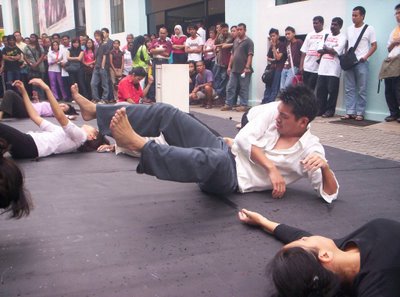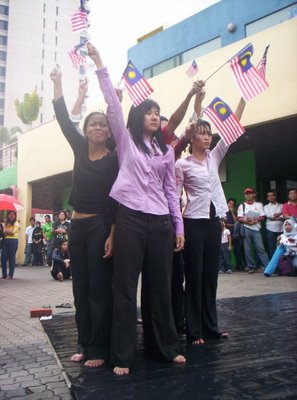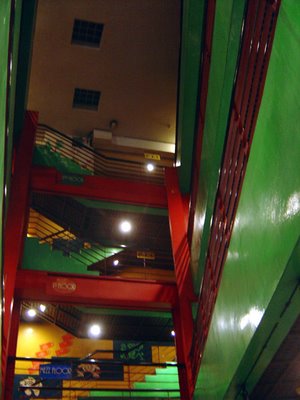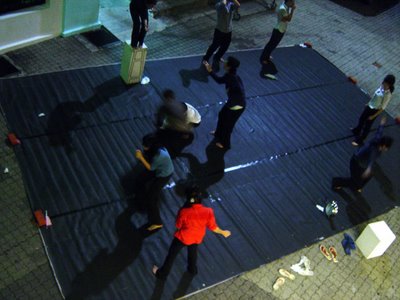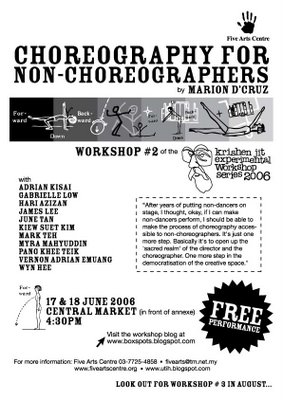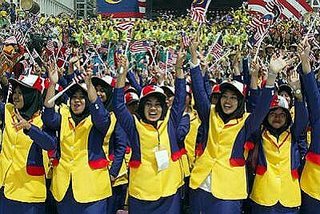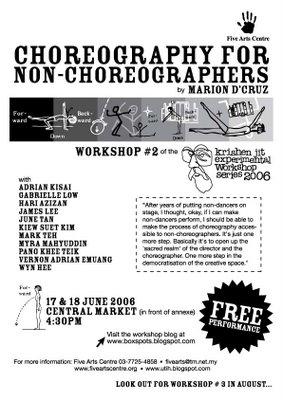Choreography for Non-Choreographers
Marion - After years of putting non-dancers on stage, I thought, okay, if I can make non-dancers perform, I should be able to make the process of choreography accessible to non-choreographers. It's just one more step. Basically it's to open up the "sacred realm" of the director and the choreographer. One more step in the democratisation of the creative space.
Friday, June 30, 2006
Tuesday, June 27, 2006
Laporan Projek
What worked well for you in the workshop?
That so much freedom was accorded to us as choreographers. (Thanks, Marion! PeluXXX) The diversity of concepts, choreographic approach, and various skill sets were exciting, challenging and exhilarating. It was a really beautiful experience to see everyone so accepting of each other.
What did not work so well?
That individual choreography sessions operated in modules of 30 minutes, and that it took about a week before the subsequent round. I had so many things going on in my head but could only try out a small fraction of it. I struggled with a constant battle: whether to add stuff or refine stuff.
What do you want more of?
More time. To experiment, to play a little more. To fine-tune and hone certain aspects. More physical work-outs. More exercises to understand the real limits, or full extent of, human movement.
What do you want less of?
Nothing. I wish we could have had more of everything, really.
What did you learn?
That I can do 100 sit-ups, and that I must remain physically active if I am to keep up with this gang. That I pout and frown more than I should.
What did you like?
The joy of creating, rehearsing, and eventually performing. I really, really liked the diversity of concepts.
What did you not like?
The realisation that I have less control than I thought over my pouts and frowns ... and my blurring out. Scary.
Suggestions for next workshop and/or other workshops:
Can we just get everyone together and let's do stuff again? Soon? Please???
Friday, June 23, 2006
Thursday, June 22, 2006
the wonders of Google
deys,
found these blogs with photos and reviews. Enjois.
Gee's Loud Frequency
Nizam Zakaria's Limau Nipis
dDoinkster Speaks
Jasiminne the Penguin
Sunday, June 18, 2006
synopses of the 11 non-choreography pieces
1. Will You Please Be Quiet, Please?
Most of the time people don't mean what they say, because most of the time their emotions dictate their choice of words and the way they speak. And emotion is something people can't control but only suppress.
2. 24 minutes in Kuala Lumpur, 64 minutes in Jakarta
This piece uses humour to explore the themes of greed and consumption, as well as labour and inequality. The title refers to how many minutes an average worker in the two cities must work to afford a Big Mac, according to a worldwide survey on prices and earnings, conducted by a Swiss investment bank.
No more heartbreaks! Let’s take a picture with a big smile!
"You say I took the name in vain / I don't even know the name / But if I did, well really, what's it to ya? / There's a blaze of light in every word / It doesn't matter which you heard / The holy or the broken Hallelujah." - Leonard Cohen.
In our closets, we are desperate to celebrate the love we have. I want to celebrate the struggle, which also includes the struggle to justify, to make sense of our feelings.
What we see in public -
Kids purest hands holding and hugging,
Whereas lovers loving, hugs and kisses,
Labeled as immoral,
Purity. Appetency. Sensibility…
Who has the ability to draw the line of MORALITY?
7. Don't wake me up, I'm sleeping
"Then they came for me and there was no one left to speak out for me." - Pastor Martin Niemöller.
Like many non-Bumiputera Malaysians, I was struck by the phrase in Yasmin Ahmad's film Gubra, "It's like being in love with someone who won't love you back." Even when someone or something gives you so many reasons to walk away, or leave, hope can be an amazing, awesome force.
10. Cita-cita saya
Saturday, June 17, 2006
bahan-bahan bukan koreografer untuk 'Buang Ruang Kurang Kurung atau Tiap tiap hari, Khabar Angin Lama, Surat Khabar Sama'
Friday, June 16, 2006
Unrequited
UNREQUITED: adjective - not returned in kind (Example: "Unrequited (unanswered) love"), of a feeling, especially love) not returned or rewarded.
Music: "No More Good Guys" by SKINDIVE
Like many non-Bumiputera Malaysians, I was struck by the phrase in Yasmin Ahmad's film GUBRA, "It's like being in love with someone who won't love you back." Even when someone or something gives you so many reasons to walk away, or leave, hope can be an amazing, awesome force.
Skindive's "No More Good Guys" is the song that I will be using for our final project. I heard this song on the final episode of Season One in "Queer as Folk", just after a tragic bashing of one of the main characters.
I liked the sound of the song, which I felt was dead accurate, and went looking for the lyrics. Even within the pain of the song, there seemed to be a glimmer of hope and a searching for strength.
Soon I found the MP3 online, and after repeated listening, the song seemed to say that even from pain and suffering, if you looked deeper inside you'd find a reason to be hopeful.
It made me think of the line in Gubra, "It's like being in love with someone who won't love you back." And the pain that comes out of that.
I hope to use this song in a manner that tells all Malaysians that if we would take action, perhaps "the pain inside will stop".
Here are the lyrics (WITH CHOREO-CUES):
(Note: 8 COUNTS to a musical phrase, even counts on snare when singing begins)
(SUM OF THE PARTS) Musical intro (4 X 8 counts, FROZEN, on first half phrase - then into slow walk)
I died today,
but I'm still breathing,
bleeding,
for now,
I'm broken.
(**gunshot** - I'd like to insert like a Group Accent here)
You left me here,
Capsized and sinking,
thinking, right now,
there's no more good guys.
(Music swells)You left me standing here,
(Music swells) alone and colder,
(Music swells)I hope that some day soon,(BROWNIAN starts on 3rd swell)
the pain inside will stop. (FREEZE on stop)
(Music - Phew - ALL FROZEN)
(MELTDOWN - June) You died today,
but you're still breathing,
in my mind, (MELTDOWN - Hari)
that is,
there's no more good guys.
(**instrumental - 4 X 8 beats**)
(MELTDOWN - Mark)
(MELTDOWN - ALL)
You left me standing here, (roll and pulsate to form STEPPING STONES on standing)
alone and colder,
I hope that some day soon,
the pain inside will stop (STEPPING STONES formed, Myra starts climb on 'see me')
I hoped you'd see me,
I hoped you'd understand,
Or crucify me for my failings,
my cruel ambition,
hardly justified,
and the pain inside will ... stop. (Myra falls into Adrian's arms)
(Cannon to stand - walk in procession)
Concepts:
Group dynamics: Alone - Together
Movement - stillness: Message - reflection.
Tableaus - The epiphany
Seeking the dancer in Everyman
 New Straits Times,
New Straits Times,Friday, 16 June 2006
If non-dancers were to choreograph everyday movements to elevate them to acts of artistic expression, how creative can they get? FARIDUL ANWAR FARINORDIN finds out about the challenges in Five Arts Centre’s experimental workshop.
IF you expect to see filmmaker James Lee doing pirouettes at a workshop by Marion D’Cruz this weekend, you’ll probably be disappointed.
Lee, who joined the six-week long experimental workshop titled Choreography for Non-Choreographers with 10 other “non-dancers”, will be performing a series of short choreography pieces at Central Market in Kuala Lumpur tomorrow and Sunday, at 4.30pm.
He won’t be doing any of those fluid balletic movements.
“Make no mistake, choreography is not dance,” said D’Cruz during the group’s rehearsal recently.
The artistic endeavour is her first creative project in seven years since 1999’s Playground. It is part of the Krishen Jit Experimental Workshop Series, a year-long tribute to Krishen organised by Five Arts Centre.
“Our choreography looks at everyday movements, which are then exaggerated. This is actually derived from a ’60s post-modernist tradition which broke away from spectacle performances. A simple act such as drinking coffee can be developed into a complete dance piece,” she explained.
Among the movements that are turned into choreography (as written on a big piece of paper stuck on the wall in the Five Arts Centre’s rehearsal space in Taman Tun Dr Ismail, Kuala Lumpur) are walking, rolling, sitting, walking, running... well, you get the idea.
All of the works are choreographed by the participants, where they are free to use text, music and spoken words according to the themes selected — from pain and healing to materialism and conformity.
This art form also comprises slow and abrupt movements, contorted facial expressions and catatonic poses.
Apart from Lee, the other participants are Adrian Kisai (theatre production manager), Gabrielle Low (youth theatre group member), Hari Azizan (journalist and theatre director), June Tan (stage manager), Kiew Suet Kim (actor/director), Mark Teh (community arts facilitator), Myra Mahyuddin (theatre worker), Pang Khee Teik (editor), Vernon Adrian Emuang (actor) and Wyn Hee (production manager).
D’Cruz said the experimental workshop is aimed at opening up the “secrets” of choreography to non-choreographers based on the premise that “there is a dancer in everyone”. It explores various approaches to movement and choreography.
At the rehearsal, participants underwent rigorous physical exercises, from 100 sit-ups — or was it 110? — to sets of stand-and-fall routines evoking pain even in those watching.
“They are in much better shape now, with stronger bodies and a clearer focus,” said D’Cruz, who teaches Improvisation at Akademi Seni Kebangsaan.
Working with non-dancers, she said, allowed her to focus on exploring each person’s untapped creative space and “allowing others to be in that space”.
It is an organic creative process, so there is no such thing as jadi or tak jadi.
For the project, D’Cruz only wanted people who had no prior experience in choreography because “dancers will come and think that the project is all about dance choreography and will be very conscious of their movements and the aesthetics, which defeats the whole purpose of the workshop.”
She continued: “Non-dancers have a more expansive imagination and their thinking is not limited to a certain understanding of what dance and choreography are.”
Each participant is required to choreograph a five-minute piece each, based on their own imagination and their understanding on the basic concept of choreography, as taught by D’Cruz in the previous weeks.
“We had the first full run yesterday, with all 11 pieces performed in a continuous sequence. In terms of learning some choreographic skills, shaping a piece together and making others understand a person’s creative vision, the participants have done really well for themselves.”
The performance will be held at the entrance of the annexe building, Central Market. More information about Choreography for Non-Choreographers can be found at http://www.boxspots.blogspot.com
Message in the movement
 The Star, Friday, June 16 2006
The Star, Friday, June 16 2006Dance doyenne Marion D’Cruz takes on the second workshop in Five Arts Centre’s first-ever Krishen Jit Experimental Workshop Series. NILUKSI KOSWANAGE gets a glimpse of the creative process involved.
THE game plan is simple: take 10 individuals with little experience in dance and choreography and put them into an intensely creative workshop environment for seven weeks. Each participant has to choreograph a five-minute work of physical movement addressing any theme or issue in which all other nine participants have to be included.
Such dynamics are reminiscent of the late Krishen Jit’s vision to make the artistic process more collaborative and inclusive. However, for his wife Marion D’Cruz, it gets a little more personal.
“When Krishen came into my life, he turned most of my ideas and conceptions upside-down. This workshop celebrates this sensibility by having these non-dancers take charge of the choreographic process and place themselves in a potentially upside-down situation,” she said.
Nevertheless, the workshop firmly remains as a part of D’Cruz’s own artistic sensibility and outlook.
Often enough, it has involved collaborating with non-dancers whom she considers to have a more innovative movement vocabulary than dancers instilled with specific vocabulary.
“I have always pushed non-dancers onto the stage for many years because they are more willing to explore the possibilities of their bodies. So I figured that if I could get non-dancers to perform, I could go the extra step and make the process of choreography open to these non-dancers,” she said.
However, D’Cruz insists that the workshop is not geared towards choreographing technically flawless dance pieces.
“It is not about dance per say but it is really about seeing and understanding how the body can convey so many different messages, ideas and conceptions. While I do teach some basic choreographic techniques that can be taken up or discarded at will during the workshop, the main point is to get the participants to think creatively about using their bodies in any setting,” she said.
“The word ‘choreography’ is not always associated or used with dance. You can choreograph a political act or a war, you can choreograph a date, you can choreograph a meeting with your boss.
”Choreography is about positioning yourself in a situation, to get your opinion or message across and this is exactly what we are doing in this workshop, except we remain firmly in the realm of physical movement.”
While the workshop is open to non-dancers and non-choreographers, D’Cruz has taken most of the participants from the local arts community.
“Most of the participants have their own pre-conceptions on the choreographic process, so it would be interesting to see how they can bring together their own artistic experiences and ideas to this workshop. To put it simply, the workshop helps to empower them in any way they see fit,” she said.
The end-point of this intensive seven-week workshop is a 50-minute site-specific performance at the alley-way between Central Market and Liquid Room dance club, which will feature each participant’s five-minute performance.
“Making the performance site-specific is just a part of democratising the creative process. Performing on a stage forces the performer to define his or her work and this can constrain the creative process. With a site-specific performance, the work can be liberated from confining labels like dance and theatre,” she said.
Whether the performances get noticed is almost beside the point; the benefits of stretching creative muscles in an open, exploratory atmosphere will accrue in any case to these budding choreographer-performers and to the rest of the arts community.
The gamut of participating choreographer-performers who will perform this weekend is as broad as it can be – Kiew Suet Kim works as an assistant producer for a theatre company; Mark Teh, a seasoned performer from the youth arts collective, Akshen; Phang Khee Teik, the caustic editor of Kakiseni.com; Hari Azizan, a full-time reporter for The Star; quirky film-director and part-time photographer James Lee; June Tan, a trained biologist who works for the oil and gas industry while moonlighting as a stage-manager; theatre veteran Vernon Adrian Emuang; Gabrielle Low with her experience in working for non-profit organizations and theatre; Myra Mahyudin is a recent graduate from UITM, who is exploring theatre for now and Wyn Hee, who helps with Dramalab productions.
Interestingly, D’Cruz will take a back-seat during this creative process.
“In the end, the workshop is really about them and not about me. This is their chance to be garang so that they can intensively shape their choreographed works into something unique and thought-provoking. I will just give them certain tools and tricks on the choreographic process and after that I shall just watch,” she said.
This has also been quite liberating for D’Cruz.
“Before, I would take a more prominent role in collaborating with dancers and non-dancers. I would piece together all the different movement and ideas from everyone and give the piece an actual structure. Now, I just want to share the making of the creative process and watch freely how it unfolds – it can be as interesting as watching the end-product itself,” she said.
Performances from the Choreography for Non-Choreographer will be staged this Saturday and Sunday at 4.30pm in the alleyway between Central Market and Liquid Room.
Admission is free. To check out how the workshop participants are faring in the creative process of putting out a site-specific performance, log on to the workshop blog at www.boxspots.blogspot.com.Monday, June 12, 2006
Wednesday, June 07, 2006
the original inspiration for Adrian's piece!




 This is Peter Crouch, unorthodox 6 foot 7 Liverpool & England beanpole striker with his avant-garde goal scoring dance. Check out the body-popping robot moves at Youtube.
This is Peter Crouch, unorthodox 6 foot 7 Liverpool & England beanpole striker with his avant-garde goal scoring dance. Check out the body-popping robot moves at Youtube.

